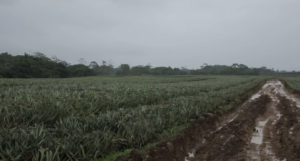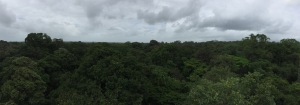I will just preface this by saying, “I am not a mycologist”.
With that said, I am a microbiologist, characterizing the mechanisms that drive bacterial diversity. Now, studying microbial ecology is a bit different than traditional ecology. You do not have the wonderful experience to capture your study organism in the field, or see a glorified mating ritual. What you do get, is the excitement of seeing a successful next-gen PCR run come back clean, ready to be sequenced. Or the fascination of processing terabytes of sequence data for down-stream analysis. Further, the fieldwork, at least for me, is almost nonexistent. Now, don’t get me wrong – I live for this field. I love processing data and find that how microorganisms dictate almost all broad-scale ecological processes to be utterly fascinating. To this day, I am blown away how large of an impact these litter bugs can have.
So, when I first ventured into the field down here in Costa Rica, I was expecting to see insects, the coolest frogs ever, and, most excitedly, large mammals. To my surprise, I did happen to see a lot of insects, however, they were not the most welcomed ones – mosquitos! However, in all seriousness, these giant primary tropical forests almost appear desolate. You have this amazing biodiversity of plant species, but, to the untrained eye, there is really nothing else to see. You rarely see a howler monkey grace you with its presence in the tree canopy, nor do you ever see the elaborate and beautiful snakes that are indicative of the tropics. But, as you look more closely, an entire world begins to unfold.
At the smaller scale, there is an entire world to be seen. You have colonies of leaf-cutter ants marching through the forest, harvesting leaves for its fungal garden. There are dung beetles carving out its delicious meal, ever ready to present its glorified treasure to a mate. And as you continue to examine this world, you come across one of the most interesting branches of life. Fungi. This clade is responsible for the vast portion of decomposition in terrestrial systems. Without fungi operating at the level that they do, life would simply not be the same in the tropics. The soil here is very nutrient poor, and most of the usable nutrients are locked in living biomass. Because of this, the turnover rate by fungi (and of course bacteria!) to recycle these nutrients is essential. I told you it’s cool that microorganisms dictate everything!
Of course, this information is not new, nor was it to me before I set foot in Costa Rica. However, what I didn’t expect to see was the morphological diversity that was on full display in all its glory. I would have never thought that a decomposing log in the middle of the forest would captivate and demand my attention. But these logs in particular, are the playground for these eukaryotes. There are clonal colonies of these fungi creating a vast and integrative network of mycelium, culminating in the production of these beautiful mushrooms. Beyond the decomposing logs, you see mushrooms sprouting up aboveground, evidence of the potential for these organisms to grow beyond belief. What few people seem to realize is that most fungi form these mycelium mats, creating giant organisms of massive size with the ability to become the largest organism in the world!
Fungi extend beyond the limitation of decomposition; and can have potential detrimental and pathogenic effects to all forms of life. Most interestingly, is the story of the zombie fungus (Ophiocordyceps unilateralis), as described by Alfred Wallace in the 1800s. I had the privilege to witness the effects in all its glory on a trip to La Selva. This fungi infects social insects (in my case, the mighty bullet ant) by using enzymes that have been deposited within the fungal spores to breakdown the armor that is the exoskeleton. Next, the fungal spread within the insect causes a truely unique and horrifying effect. Inevitably, the insect becomes a puppet, fully manipulated by the fungal pathogen as it reprograms the ant’s entire social behavior. The obediant and systematic social insect that has developed over eons of evolutionary time is disrupted within just a few days. The ant leaves its nest or foraging trail, abadoning its family, to find a suitable habitat for its newfound master. The ant then climbs onto a stem and secures its place on the underside of a leaf, using its giant mandibles to fixate its location. It is here that the fungal pathogen shuts down the ant altogether, muscles atrophy and the infamous fungal ‘death grip’ is in full effect. The mighty ant, who is capable of lifting thousands of times its own body weight, is left helpless and paralyzed on what will eventually be its final resting place. The hyphae continue to spread throughout the ant, eventually killing its host who, at this point, has served its full purpose. Eventually, fruiting bodies grow out of the head of the ant, releasing spores from this advantageous position high up on the leaf of this plant. These spores disperse and are ready to fall onto the next unsuspecting ant brigade, starting this fascinating process once again.

Zombie fungus (Ophiocordyceps unilateralis) fruiting body erupting out of a bullet ant (special thanks to Bernal Matarrita [Univ. of Costa Rica] and Alex Wild)
In conclusion, microorganisms are awesome! The more you learn, the more convinced you will become, I guarantee it. Since I cannot take photos of bacteria (which equally have a number of amazing stories), I settled for fungi. I could not stop from taking photos of the vast diversity of fruiting bodies – some smaller than a pencil point, while others were as large as a person. Below you will find some of my favorites, most of which I have zero idea what they are (all input will be much appreciated!). To conclude, I am not a mycologist, but that doesn’t stop me from enjoying and appreciating the unique stories and beauty each of these little guys has to offer!
PURA VIDA!
Thanks for listening!
-Alexander Chase
at the Martiny Lab at University of California, Irvine














9.748917
-83.753428





















































